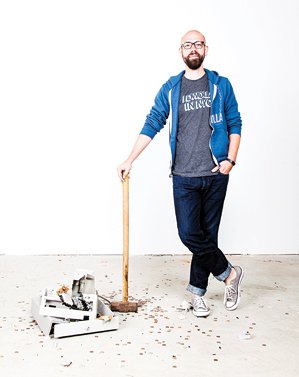The Internet can move data from one person to another in a fraction of a second. Why can’t it do the same for money? Ben Milne asked himself that question, and the answer led him to found Dwolla, a digital payment network that could make it faster, easier, and safer for money to change hands.
Dwolla is on track to process over $1 billion for 250,000 consumers and businesses in 2013. It has amassed $22.5 million in venture capital and emerged as a threat not only to the likes of PayPal but also to venerable institutions such as Visa. Yet Milne is not a financier or a university-educated wunderkind. He sports the shaved head and full beard of a San Francisco hipster, but he’s an Iowan who is building his company in Des Moines.
Seated in a conference room at the Silicon Valley offices of his latest investor, Andreessen Horowitz, where the founders of Twitter and Skype got funding that led to Internet glory, Milne discusses the complex world of payments with confidence and liberal use of the phrase “the reality is.”
“The reality is, the way we exchange money makes money worth less,” he says. If you sell something for $100 with a $10 margin, your profit would be $7.50 or less if the customer paid with a credit card. “You can’t drive down the fees with regulation, because that’s the technical cost,” he says. “To remove it, you need a better mechanism for exchanging value. That’s Dwolla.”
Milne grew up in Cedar Falls, Iowa, where he passed the time playing soccer and repairing broken appliances his grandmother collected. When he was in middle school, his father, a dentist, was diagnosed with Parkinson’s disease but was determined to do as much as possible while he still could: he built a public soccer stadium and golf course. Those actions held an important lesson for Milne. “I remember thinking, he didn’t know anything about that, but he figured it out and did it,” he says. “I realized that all you need to do, a lot of the time, is decide what you want to do and just get it done.”
Milne started his first company, which made audio speakers, with $1,200 in savings in 2001, while he was a senior in high school. He dropped out of the University of Northern Iowa to build the business, and by 2008 he was racking up $1.5 million in sales annually. But he was troubled by costs. “We were spending $55,000 a year in credit card fees,” he recalls. “I thought, that’s insane. I’m making the sales, and I just sent these people’s kids to college.”
Milne became convinced that no solution existed and that the only way to get one was to build it himself. Over the next two years, he figured out how to do it. “He would commit himself to doing seemingly impossible things,” recalls Matt Harris of Bain Capital Ventures, who funded Dwolla during this period as a managing partner at Village Ventures. “Then we’d meet three months later, and he would have done them and have a new set of impossible things.”
Dwolla launched nationally in December 2010 and was moving $1 million a day in July 2011. By the end of last year it was doing nearly three times that volume. “It was not a beautiful, predictable, calculated process,” Milne says. “It was ‘Don’t go broke and don’t stop.’”
In a market overflowing with mobile payment services and digital cash schemes, Milne’s service is unique. Nearly all electronic payment systems, including PayPal, are built on the four financial networks that carry noncash transactions. Dwolla (as in “dollar” plus “Web”) can avoid all of them. It has built its own network, known as FiSync, that connects to banks directly. So Dwolla doesn’t need to pay fees to anyone. It can be used in just about any scenario: at a cash register, from a phone or a desktop PC, person to person, business to business, bank to bank.
Merchants get the most obvious benefit: the recipient of a Dwolla transfer pays 25 cents per transaction over $10, but nothing for deals worth less than that. Compare that with the 2 to 3 percent plus 30 cents per transaction typical of credit cards and gateways to credit networks. For consumers, the system is simple: they can send money to an e-mail address, phone number, Twitter handle, or Facebook friend; the recipient will get a message prompting him or her to sign up with Dwolla to accept the money. And banks benefit because Dwolla can move money in real time, a capability no other network has. The Automated Clearing House, or ACH, the bank-to-bank transfer system that credit and debit cards depend on, theoretically settles in 24 hours. But in practice it can take up to five days, creating a risk that payers will turn out not to have the money they thought or claimed they had at the moment of a transaction.
FiSync also adds layers of security. Among other things, money is transferred by means of digital tokens that confer authorization to execute specific transactions; account details themselves are not transmitted. Consequently, Dwolla claims fraud rates an order of magnitude smaller than other transaction systems do.
Technically, FiSync is simple. Logistically, it requires that Dwolla ink deals with every bank in the country. That’s because each bank maintains its own database of accounts. A given institution can transfer funds electronically within its own walls instantly and freely, but to go outside, it needs to use the ACH or wire networks. FiSync would replace those by connecting to every bank’s database directly.
Milne has signed up only 16 financial institutions but says he is on the verge of dramatically expanding that number. It will take a lot of legwork, but he is ready to proceed bank by bank. “In Silicon Valley, people are looking for a silver bullet,” he says. “I look at it like a Midwesterner: I have an ax and I’m going to cut down a tree. You close the first customer, then the second, then the third. It’s hard work, but that’s the way you do it.”
—Ted Greenwald





